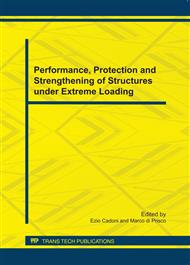p.362
p.368
p.374
p.380
p.386
p.392
p.398
p.404
p.410
Simulation of Seismic Load Resistance of Core-Walls for Tall Buildings
Abstract:
This paper addresses the seismic performance of core-walls based on an experiment and numerical analysis on two 1/7.5 scaled L-shaped concrete core-wall specimens. Concrete strength was 77 MPa and the yield strength of vertical reinforcement was over 700MPa. Test variable was the loading path on the axial load – lateral load relation. Axial load was varied as high as 6MN or 50% of the axial load capacity for one specimen and 4.2MN or 35% for the other specimen as a linear function of the lateral load. The lateral load-drift relations were recorded with local deformation and damage, focusing on the yield of reinforcement and crushing of concrete. Damage of columns was severe and indicated the importance of good confinement at this region for better seismic performance. The numerical models with finite shell elements well simulated the intensity and extent of damage in addition to backbone curves of lateral load - drift angle relations when the pullout of longitudinal reinforcement of columns is considered.
Info:
Periodical:
Pages:
386-391
Citation:
Online since:
July 2011
Authors:
Keywords:
Price:
Сopyright:
© 2011 Trans Tech Publications Ltd. All Rights Reserved
Share:
Citation:


